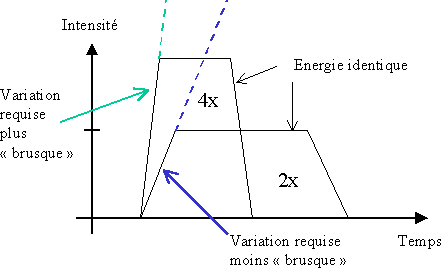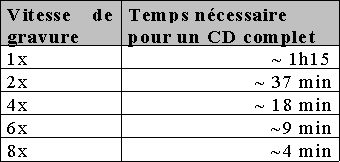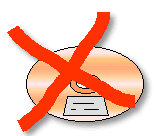You're here : Hardware >Fiat Lux !
Since CD-burner are democratized, and since the low cost of CDRom (less than 1,5 ?, even less than 1?), CD-burning has become one of the most activities of computerized musician (if I dare such a denomination).. Able to show Hi-fi format demo version, archive of data, incredible ratio price/MO, many advantages indeed.
But a major drawback : Time, my friends, Time who is so expensive nowadays. To Burn a CD-R last longer than making a copy from HD to HD. Almost as prehistoric that the answering time of a floppy disk, gush !
The major commercial argument of CD-burner constructors (so far for CD-reader too) : the speed. Yesterday, x4 or x 6, now x 12, x 20 , tomorow, x 40 maybe x 100. A CD-rom fullfilled in less than 2 minutes is close from our hands.
As a comparison, transfering data from one HD to another HD takes 1 minute to 1 minute 30 sec.
Nevertheless, you can ask one question : what about the quality of the CD after burning process ? With the increasing of speed, is it getting worth or better ? Very important when you know this point penalized this media against other solutions for years ?
What's up doc ? Any danger if I burn to fast ?
As in everywhere, opinions are different, sometimes against. In my opinion, I'd rather burn at low speed (we'll see why later, in which conditions) even if some say it doesn't matter.
Here are some arguments for high speed :
 1 - The gyroscopic phenomenon of disk rotation at high speed make the CD movement more stable (same as a spinning top, the faster itgoes, the more stable it is).
1 - The gyroscopic phenomenon of disk rotation at high speed make the CD movement more stable (same as a spinning top, the faster itgoes, the more stable it is).
 2 - The power of the laser is stronger when you burn at fast speed, so the hole burned on the CD are cleaner.
2 - The power of the laser is stronger when you burn at fast speed, so the hole burned on the CD are cleaner.
 3 - Burning at fast speed can avoid some mistakes or unprecisions of the laser. It's just as you'd better record at fast speed with a audio track recorder.
3 - Burning at fast speed can avoid some mistakes or unprecisions of the laser. It's just as you'd better record at fast speed with a audio track recorder.
I will say that only the first point is, in my opinion, a true argument for recommending fast CD-burning (expect shorter time, of course). However, we have to say that the second point is more important if you use CD-burner with low mechanism. If you have good CD-burner, this point is useless. If the CD has a bad quality (meaning weight not equaly shared on his surface) a ugly phenomena, wellknown in physics will appear. It will cause some vibrations getting more intense with the increasing of speed. As you can see, nothing is easy...
No stickers on the CD to be burnt or read, esspecially at high speed.A throw off, even the smallest, may sometimes create mechanism vibration which can affect the burn process, indeed destroy some of the mechanism items of the CD-burner
Some precisions had to be added for point 2.
The quality of burning (the one who is important, the one that make the CD readable for years) is, for the larger part, a question of how deep you burn. The depth (difference between two points, one being burnt, the other no) increase the amount of energy received by a point, and increased itself in two ways : increase laser power ou increase time spent by laser on each point. And, of course, if we increase the speed, the time spend on each point will be shorter
So, point 2 seems to show things in the wrong way, and illustrates a nonsense. To have a same precision for the marks, you must have a higher power at high speed than at low speed. YOU MUST ! This doesn't mean that you always have this power. In commercial CD-burner, the constructors seem to put powerfull laser, ok, but sometimes not enough powerfull (due to price). If you can choose your speed, always take the lowest. In such a way, you can be sure than the laser will be strong enough.
For the third point, I only say NO for one good, simple reason :
For the third point, I only say NO for one good, simple reason : if it is common to say that it's better to record with high speed with a track recorder. It's mainly due to the density of the information on the track : the faster the track goes, the lower is the density, and the best is the restitution quality (dynamic transition are clearer) and the preservation in time is better (less danger of hitch flaw or erosion of dynamics transistion). Drawback : for a certain track, less time for recording at high speed than low speed (15 minutes for a tape a high speed instead of 30 at low speed). Nothing to do with CD. No matter what the speed is, the density of information still remain the same. You will always burn 74 minutes of audio data. In a way, it's the opposite that happens with the tape : when you double the speed, you ask for a double power for the laser, but you also ask for double time less to oscillate from high state to low state. What a job for a so small thing if she is poor quality built. For instance, I'm not of good quality. If you ask me to go up and down 10 steps in 30 seconds for halt an hour, with no rhythm mistakes, i'll probably do it. But, ask me now to go up and down 20 steps in 15 seconds without loosing the rhythm, even if it last only 15 minutes ! wanna kill me ? )

High speed burning process ask the laser brutal variation between high and low intensity, and a faster rhythm than at low speed. Even if a specific laser can produre enough power in theory, only the stronger will last in time with these constrains
n a summary :
It's no use to compare the speed of two CD-burner because this criteria involves another criteria than speed (mechanism elements, quality of the laser...) For instance, a well choosed CD-burner x4 will deliver better result than a bad x2 one.
On the other hand, for a given model (at the end, you often only buy one), if the CD-burner let you choose between different speeds, better choose the lowest speed. It's the guarantee of enough power for the laser, and finally, a better burnt of the CD.
Last argument for low speed : decreasing speed decrease also the required data flow (a CD-burner might never, never, be with no data because the laser can't be switch off during a burning session). Having a lower data flow can avoid some data transfers mistake when the source is not good (another CD, a low bus, a low HD). For this point, the buffer size (the RAM stack used for transfer between source and destination) is the most important point. A too small buffer won't let you burn, in any way, at high speed. A good advise could be : test the buffer before burning if your burning software give you the opportunity to make a blank simulation.
I will end like that (ouah, wasn't it a bit too long ?)
Glory to low speed ! And F... people in a hurry! (Well, this is the best reason to take a breath... the computer is unavailable during the burning process. The longer is last, the longer you can sleep ;-)
At last, : if you burn at x2 or x 4, use a fast enough source and be sure to use CD-R guarantied for writting at the given speed.
Thanks to :Gilles Blais, Pipine, Michaël Korchia, Christophe Chenevard, Olivier Carpentier, and everybody else, the cubase Mailing list for all the discussions we had on theses points and which are the start point of this article.
Arnaud LE BOULANGER, on the 10-10-1998
Page viewed 8786 times


![]() 1 - The gyroscopic phenomenon of disk rotation at high speed make the CD movement more stable (same as a spinning top, the faster itgoes, the more stable it is).
1 - The gyroscopic phenomenon of disk rotation at high speed make the CD movement more stable (same as a spinning top, the faster itgoes, the more stable it is).![]() 2 - The power of the laser is stronger when you burn at fast speed, so the hole burned on the CD are cleaner.
2 - The power of the laser is stronger when you burn at fast speed, so the hole burned on the CD are cleaner.![]() 3 - Burning at fast speed can avoid some mistakes or unprecisions of the laser. It's just as you'd better record at fast speed with a audio track recorder.
3 - Burning at fast speed can avoid some mistakes or unprecisions of the laser. It's just as you'd better record at fast speed with a audio track recorder.






